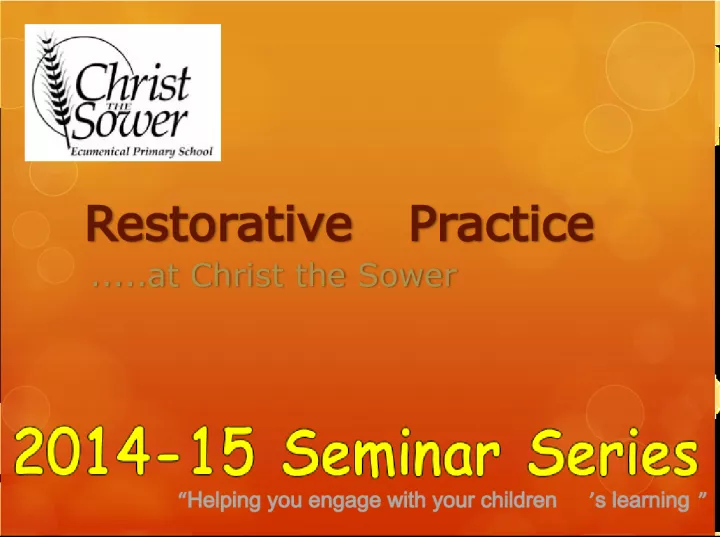Restorative Practice at Christ the Sower: Engaging with Children's Learning


Join us as we share principles and practices used on the restorative journey and explore collaboration between school and home. We focus on respectful relationships and conversations, and making progress through restorative interventions.
- Uploaded on | 1 Views
-
 kimbernhard
kimbernhard
About Restorative Practice at Christ the Sower: Engaging with Children's Learning
PowerPoint presentation about 'Restorative Practice at Christ the Sower: Engaging with Children's Learning'. This presentation describes the topic on Join us as we share principles and practices used on the restorative journey and explore collaboration between school and home. We focus on respectful relationships and conversations, and making progress through restorative interventions.. The key topics included in this slideshow are restorative practice, community building, respectful conversations, collaboration, progress,. Download this presentation absolutely free.
Presentation Transcript
1. Restorative Practice Restorative Practice .....at Christ the Sower .....at Christ the Sower Helping you engage with your children s learning
2. This evening... ...we will share some of the principles and practices we have used since 2011 on the restorative journey ...we will encourage you to try them out at home and see the power of them ...we want to explore what a deeper collaboration might mean between school and home.
3. Restorative Principles Building a community through careful use and attentive building of respectful relationships Using respectful and restorative conversations when things go wrong, using the language of who has been affected and separating out the problem from the people who created it. Holding restorative interventions when we need to make decisions about how to make progress in the future
4. Principles Our standard disciplinary systems fail to address the core relational issues, based instead on the principle that an offence is a breach of the school rules and an offence against the school , akin to our judicial system. Our standard systems ask 3 questions: Who is to blame? What rule did they break? and What is the punishment?
5. Principles and then sometimes, the question why did s/he do it and how can we stop it happening again? In general, they leave us with the feeling we have done something but we know we have actually fixed very little and the relationship remains un-repaired, all for the sake of having been firm or strict.
6. Alternatively , Restorative Practice is grounded in the principle that when something happens, it harms and damages relationships, and there is LEARNING to be engaged in to fix them. A different set of questions are asked: What happened? Who has been harmed/affected? What do we need to do to repair that harm? Principles
7. It is only when I can take responsibility for what I have done and how that has affected you, that you will feel safe enough to tell me how I have harmed you and together we can explore what needs to happen to make amends. Rather than stigmatising and excluding students, it is saying - you are part of our community, we value you, but your behaviour in this instance is not OK. So what do we need to do to include you back into our Community? Principles
8. Principles we talk about We are learning what is important: Our words and actions affect others this is our unifying principle of community. How is our words & actions (both as adults and children) helping to create the community we are trying to build? Damaging actions do not have punishments , but they do have community consequences for all of us.
9. Direction of Travel Informal/formal strategies at three levels The informal (and formal) preventative and proactive strategies and practices that build and strengthen relationships and develop community Informal interventions (with their own specific language). Problem solving around day to day problems, difficulties and conflicts. Formal interventions to deal with significant issues of harm, with a focus on repairing relationships when something has happened to damage our community.
10. Overview
11. Community-Building Circles So far, this has been the most significant part of our 3 year journey. Community-building is the key. Children who do not feel a sense of belonging to a community will have few worries about offending against that community. Building a community means that you have a stake in its success, so all the strategies we use are geared to articulating a successful community. Reinforcing and reinforced by the articulated values of the school specifically the Golden Rules and a strong Christian ethos.
12. The main strengths of our community-building circles are: An opportunity to be heard and to be valued. An opportunity to agree and then work within the agreed community rules. A chance for those who are feeling at a loss or under stress to be accepted and belong to a group. Why Circles? How Circles? When Circles?
13. Informal conversations...use specific language
14. Informal & formal interventions: a protocol for successful restorative practice.
15. Sometimes we will need to initiate restorative conferences...
16. Applications at home: a discussion
17. Using the idea of respectful relationships to develop deeper collaboration between home and school...
18. A provocative statement.... Parents, not teachers, are the chief educators of their children. We as professional educators are a junior partner in the teaching and leadership of their children. We are support players with some unique specialist insights, but junior partners nonetheless. The more we assume the professional high ground from parents, the more we disempower them; the more we seek to tell parents how children must be educated, the more we make them dependent on us for their childrens wellbeing and progress. We are in loco parentis and to that extent, we ought clearly to honour the relationship with parents in whose place we stand for 6 hours each day. ...discuss!